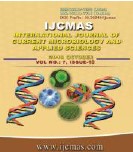


 National Academy of Agricultural Sciences (NAAS)
National Academy of Agricultural Sciences (NAAS)

|
PRINT ISSN : 2319-7692
Online ISSN : 2319-7706 Issues : 12 per year Publisher : Excellent Publishers Email : editorijcmas@gmail.com / submit@ijcmas.com Editor-in-chief: Dr.M.Prakash Index Copernicus ICV 2018: 95.39 NAAS RATING 2020: 5.38 |
The present study reports the feasibility of reclamation of a lead and cadmium contaminated soil using the solution containing organic carbon resulting from the decomposition of organic matter, an environmentally-friendly and cost-effective leachate. For conducting this experiment, three soil samples were used. Column leaching experiments were performed to test the efficiency of organic solution containing two rates of organic carbon (0.25 g/L and 0.50 g/L) for the reclamation of the lead and cadmium contaminated soil in natural conditions. Results showed that utilization of the solution containing organic carbon resulting from the decomposition of organic matter was effective for removal of lead from the contaminated soil, attaining 30.87%-74.97% of Pb in an alkaline condition. On the other hand, it was found that this concentration of carbon was not much effective for Cd removal from contaminated soil, attaining only 1.18%-24.14% of Cd. Clay content, pH and organic matter content of soil might be responsible for such differences in removal efficiency among samples. Such a reclamation procedure indicated that solution containing organic carbon released during decomposition of fresh organic matter is a promising agent for remediation of lead contaminated soils. However, further research is needed before the method can be practically used for in situ reclamation of heavy metal contaminated sites.
 |
 |
 |
 |
 |